The Lynnfield Followup: Turbo Mode and Overclocking Investigated
by Anand Lal Shimpi on September 18, 2009 12:00 AM EST- Posted in
- CPUs
GPU Limited Gaming Oddities
Scott Wasson first picked up on this anomaly in his GPU-limited FarCry 2 results at the bottom of this page. Jon Stokes pointed it out and our own Gary Key duplicated and expanded upon the results.
The situation is this: in some cases, Nehalem can go from being much faster than Phenom II, to being measurably slower within the same benchmark depending on resolution. Gary was the first to tie the issue to the GPU used. Gary found that NVIDIA GPUs appeared to behave this way on Nehalem/Phenom II while AMD GPUs didn't. In other words, NVIDIA GPUs were running faster on AMD hardware while AMD GPUs were running faster on Intel hardware. It's all very strange.
It's no surprise that Ryan and I are working on the reviews for AMD's next-generation DX11 GPUs due out before the end of September. I cloned my GPU testbed SSD and moved it over to my CPU testbeds. I then proceeded to run a subset of our GPU tests on the Core i7 920, Core i7 870, Core i5 750, Phenom II X4 965 BE and Core 2 Quad Q9450 on two different GPUs, a GeForce GTX 275 and a Radeon HD 4890.
Let's go through the results game by game, shall we?
I'll start with Gary's FarCry 2 benchmark. We're running in DX10 mode with the optimal quality defaults (latest patch) and 2X AA. Much more GPU-bound than our normal CPU gaming tests, but that's exactly what we're looking for here. The benchmark of choice is "Ranch small", it comes with the game:
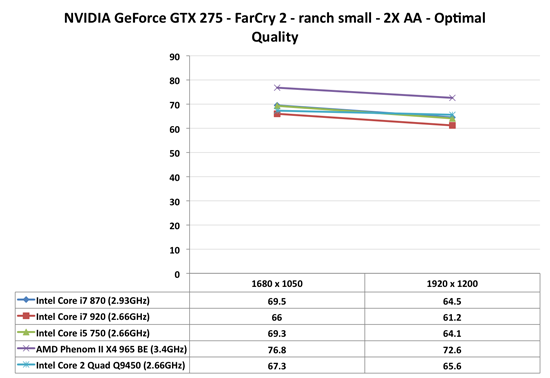
So I've duplicated Gary's results. The Nehalem cores all perform about the same, the i7 920 is a bit slower thanks to lacking turbo mode it seems. But look at the Phenom II X4, it is significantly faster regardless of resolution. Now look at the same test with a Radeon HD 4890:
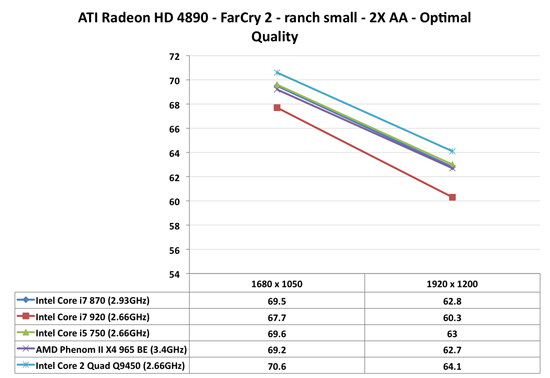
The Phenom II X4 965 BE advantage disappears completely. That's odd.
Next, I ran the FarCry 2 benchmark we're using for our upcoming GPU reviews. It's the Playback action demo with Ultra Quality defaults and 4X AA enabled. First on NVIDIA hardware:
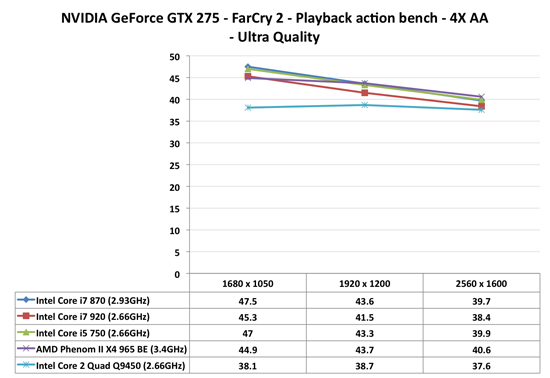
The Core i7 920 falls a bit behind the other Nehalems and while the Phenom II X4 965 BE pulls ahead slightly at 2560 x 1600, the performance is generally GPU bound across the board. An unexpected result is that the Core 2 Quad Q9450 at 1680 x 1050 is actually CPU bound. There may just be a gaming reason to upgrade your CPU after all. Now let's switch to AMD hardware:
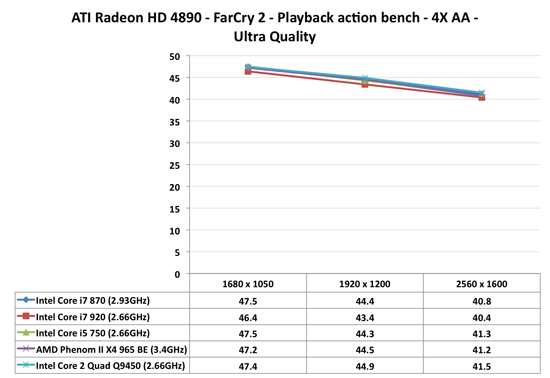
Now this is strange. The Core 2 Quad doesn't fall behind in performance, in fact it ties the Core i7 870 at 1680 x 1050. In other words, it doesn't appear to be CPU bound anymore at 1680 x 1050. Confused?
Let's keep going.
The next game I tested was Crysis Warhead. Again I ran all of the numbers in DX10 mode, this time with "Gamer" quality presets but with "Enthusiast" quality shaders. I ran the "frost" benchmark included with the initial version of the game.
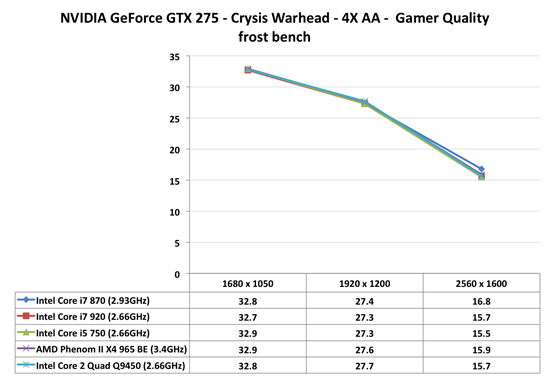
All of the lines are overlapping as they should be, we're in a GPU limited situation afterall. The 870 pulls ahead slightly at the end but it's nothing to get terribly excited about.
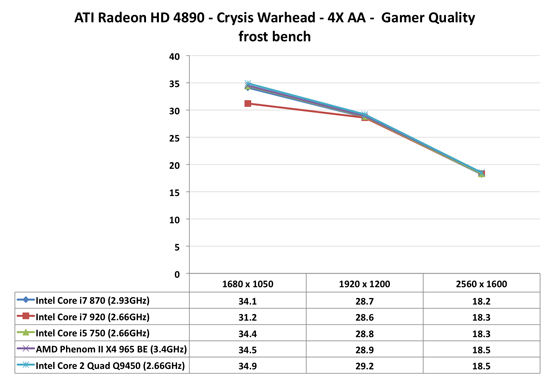
Switch to the Radeon HD 4890 and we now have an outlier. The Core i7 920 is measurably slower than everything else at 1680 x 1050. The only change we made was the graphics card/drivers. Next.
Dawn of War II is a RTS/RPG that includes a wonderful built in benchmark. I ran with all settings maxed out in the game (including turning AA "on"):

At 1680 x 1050 we actually see some performance breakdown here. The Lynnfields are fastest, most likely due to faster turbo modes. The Core i7 920 is next on the charts, followed by the Phenom II X4 965 BE. At the bottom we have the Core 2 Quad Q9450. But at 2560 x 1600 they all converge at roughly the same point. Since many users have monitors capable of resolutions lower than 1920 x 1200 it's quite possible that the differences between these CPUs would be noticeable.
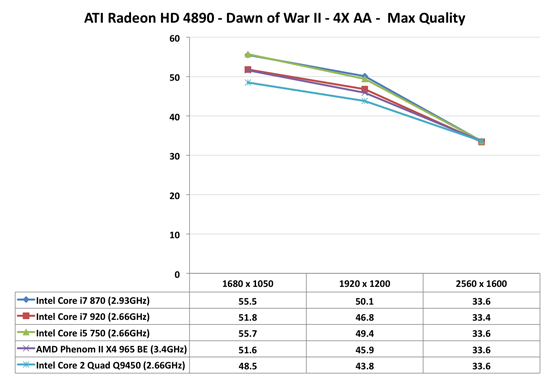
Things don't change too much as we switch graphics cards. The Phenom II X4 does a bit better with the Radeon HD 4890, but that's about the only change.
Left 4 Dead is next. All settings are maxed including Anisotropic Filtering at 16X. V-Sync is disabled and AA is set to 4X MSAA.
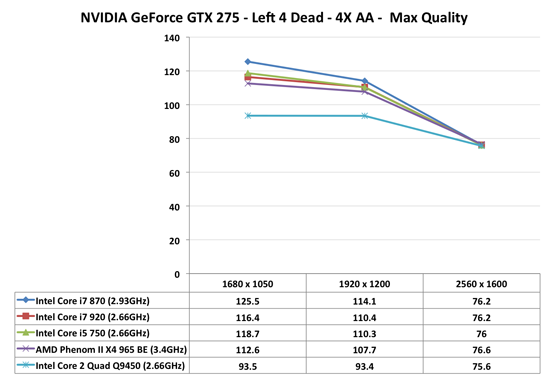
These numbers mostly make sense. The i7 870 is the fastest, followed by the i5 750 and the i7 920 - you have turbo to thank for that. The Phenom II is a bit slower and the Core 2 Quad is a lot slower. But by the time you hit 2560 x 1600, all roads lead to around 76 fps.
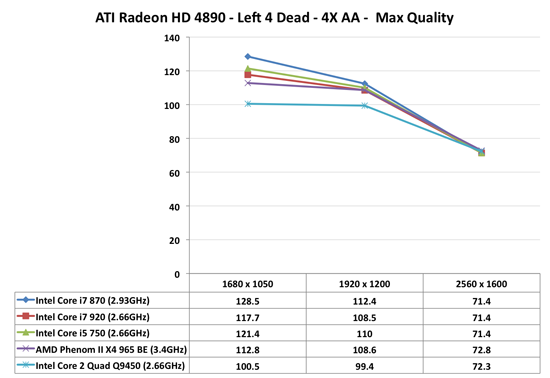
Similar behavior with ATI hardware, whew.
HAWX is a combat flight simulator that also doubles as a great DX10 benchmark. I ran the DX10 version of the game with all settings at their highest values with the exception of Ambient Occlusion, which was set to "low".
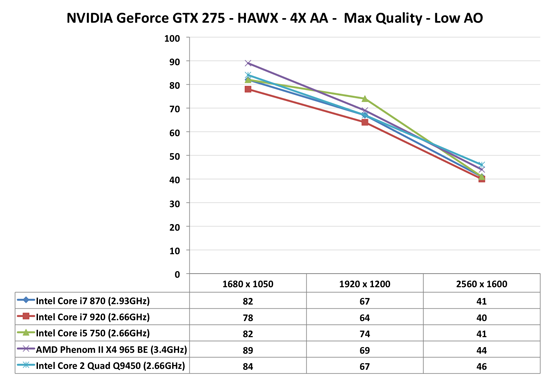
This is another one of those games where the Phenom II pulls ahead of the Nehalem processors even at a supposedly GPU-bound 2560 x 1600 resolution. The advantage isn't huge, about 7% but the Core 2 Quad gives us some indication as to what's going on. The Q9450 actually beats everything here - perhaps it's a large L2 thing? Now look at what happens with a Radeon HD 4890:
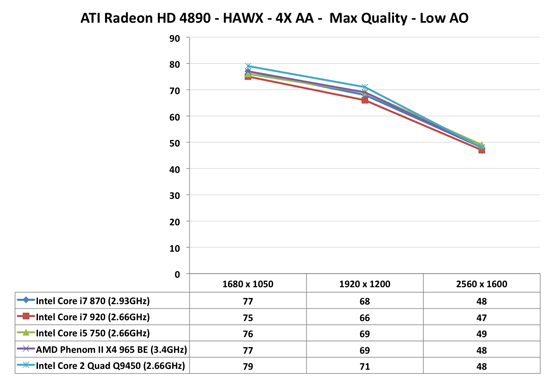
The Core 2 Quad still does better than everything else, but pretty much everything converges at the same point. The Phenom II advantage seems to disappear. So far we have HAWX and FarCry 2 exhibiting this behavior. Mental note, next benchmark please.
Our final test is Battleforge, a free to play online card based RTS. I ran with all settings maxed out:
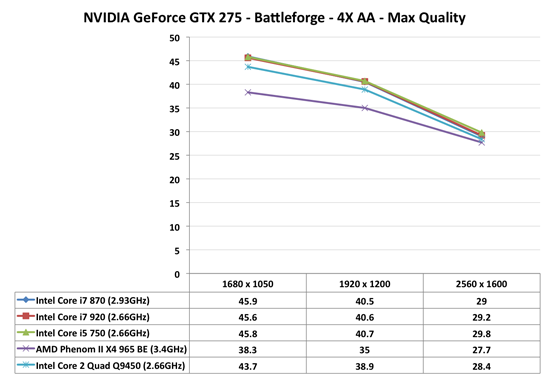
Here we see the opposite happening - the Phenom II X4 965 BE is far slower than anything else at 1680 x 1050. As expected, all CPUs tend to converge at the same point if you crank the resolution up high enough.
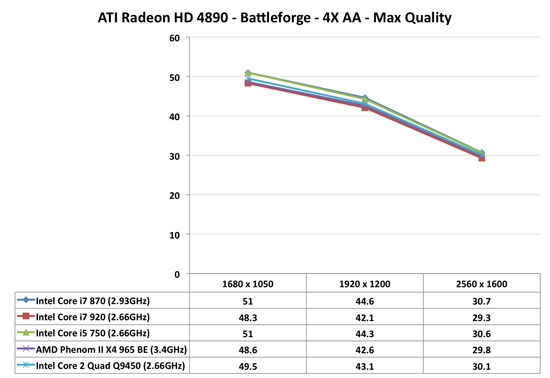
Switch graphics cards and the AMD disadvantage actually disappears. It's the opposite of what we've been seeing in games like FarCry 2 and HAWX where switching to an AMD GPU causes the AMD advantage to disappear.
What can we conclude from all of this data? Not much unfortunately. There are a couple of certainties:
1) Even at relatively stressful GPU settings, 1680 x 1050 with 4X AA enabled, some games are still CPU bound. The next-generation of DX11 GPUs will make this even more true.
2) Gaming performance isn't totally clean cut between all of these CPUs. There are situations where Nehalem is faster, Penryn is faster or Phenom II is faster. The trend appears to be that Nehalem is generally the fastest, followed by Phenom II and only rarely does the Core 2 Quad end up on top.
How do I explain the odd behavior that we've seen in some of these games? Honestly, I'm not sure if there's any one explanation. What appears to happen is a perfect storm of CPU power, GPU power, GPU drivers, cache sizes, clock speeds and instruction mix. In some cases it looks to be cache related as the Core 2 and Phenom II both do very well and have a noticeably larger L2 than Nehalem, but in other cases it's much more difficult to explain by any one variable. The fact that the situation changes almost entirely when switching to ATI hardware is what makes me believe the GPU driver is playing some role in all of this.
Ultimately it's not a big (or consistent) enough of an issue to get too worked up about, but it's definitely something real and not just a figment of testbed imagination. I've shared all of my data with hopes of figuring out exactly what's going on, but as I mentioned in my Lynnfield review - not all applications/games are going to play out the same way. I'll update you if I do find anything out.










46 Comments
View All Comments
SixOfSeven - Monday, September 21, 2009 - link
Another good piece on the new CPUs, but without some new coolers or LGA1156 mounting kits it's a little hard to put into practice. Any news on the LGA1156 HSF front?strikeback03 - Monday, September 21, 2009 - link
In the power consumption area, you list a core i7 875 and giver power consumption when overclocked. is this supposed to be an i7 975 or a i7 870 (and curse you intel for using such similar names). Would it be possible to get a table showing both a 920 and an 8x0 at some overclock at idle and load?7Enigma - Monday, September 21, 2009 - link
Anand,While many are odd, the graph that really makes my head spin is the second one that shows the 4890 on the ranch small level. For some reason the older Q9450 is significantly faster than the rest of the competition, even outpacing the 870 which has a clockspeed advantage! When looking at several other graphs with the 4890 it's again apparent that the Q9450 has some weird magic going on where performance doesn't match the expected results (FarCry2 Playback action bench, HAWX 4X AA Max Quality Low AO). I'm assuming the mobo's are different, but could that honestly make the 5-6% difference between the 920 and the Q9450? (I'm assuming you are using the same graphics drivers correct?)
This could be a piece of the puzzle that would allow you guys to figure out a possible reason.
And thank you for the followup article. While I (and many others) thought a lot of the recent comments were from trolls looking to damage this site's comments section, I was interested in seeing the OC'd power numbers and direct comparison Turbo-disabled at higher OC's (where you would likely have Turbo disabled anyways if used for a gaming boot).
7Enigma - Monday, September 21, 2009 - link
Posted this message after reading the article but before reading the comments. I think GeorgeH might be spot on as he described a reason behind what my original comment was referring too.GeorgeH, I second the beer!
GeorgeH - Saturday, September 19, 2009 - link
The GPU oddities look almost completely like a hyperthreading issue to me. There are two types of anomalies in your graphs: performance inversions (a definitively "slower" CPU performing better than a "faster" one) and line crossing (a slower CPU becoming faster at a different resolution.) Only 2 games really demonstrate these behaviors to any significant degree: Far Cry 2 and HAWX. Those two titles benefit the most (to my knowledge) from going from 2 cores to 4, implying they have the most threads running at any one time and therefore would be most susceptible to HT issues.Looking at just those two titles, the i5 performs consistently better than its i7 brethren. As the only real difference between the two is hyprthreading, I conclude HT is the culprit (as it sometimes was in the "days of yore" on the P4.) Turbo mode as well as differences in base clock speed and memory architectures mask the problem, but I'd bet money that if you turn off HT your graphs will be much more normal.
coconutboy - Sunday, September 20, 2009 - link
If true and HT is the culprit, GeorgeH deserves a beer for figuring out the anomaly. Nice spot there, dude.gwolfman - Monday, September 21, 2009 - link
What about Battleforge then with the inverse affect?GeorgeH - Monday, September 21, 2009 - link
Dunno.My guess would be that it's using some Havok technologies that are more completely or efficiently GPU accelerated on AMD/ATI GPUs than on NVIDIA ones. Far Cry 2, Dawn of War II, and HAWX all demonstrate much more significant CPU dependence on NVIDIA hardware than on ATI hardware, and AFAIK all three use Havok technologies to some extent. I don't know if Battleforge uses any Havok technologies, but its behavior does roughly match the other titles that do.
silverblue - Sunday, September 20, 2009 - link
I'm not sure if they've looked at this back when i7 itself was launched, however it's definitely worthy of a second look. Simply disabling HT then retesting may yield all the answers we are looking for, even if there's only a couple of games where this issue exists for the i7s.swaaye - Sunday, September 20, 2009 - link
Hmmm, I think that this guy's comments should be considered.